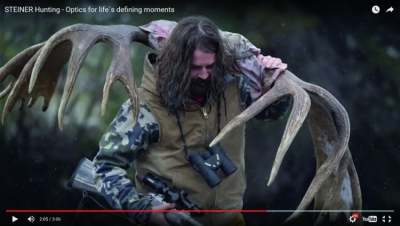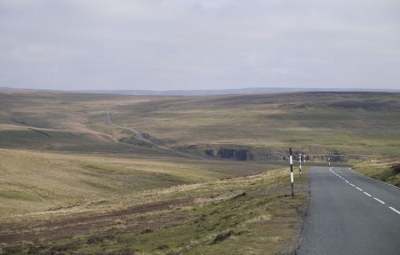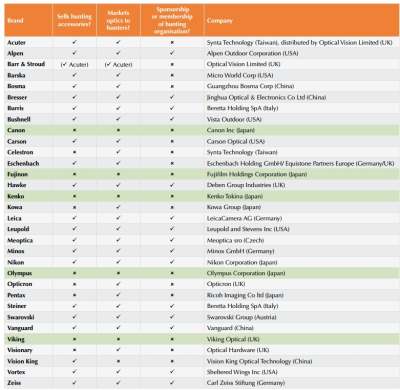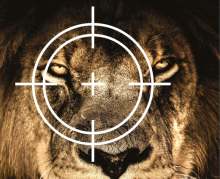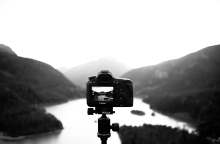As highlighted by press coverage of Cecil the Lion’s demise and the UK public’s response to Westminster trying to legalise fox hunting, the hunting of animals for fun or sport is highly controversial.
The Mediterranean song bird slaughter and the ongoing battle in the UK between the grouse-shooting industry and environmentalists provide further modern-day examples of the impacts caused by ecologically insensitive sport hunting.
These case studies also highlight the political tensions that surround the sport hunting industry; tensions that vary depending on the country and location in question.
With such an ethically complex issue, you might expect companies operating in both pro-hunting and anti-hunting sectors to be transparent or to take a definitive ethical stance. One sector that has avoided this, and has received very little examination, is the sport optics industry.
Sport optics, such as binoculars, spotting scopes and monoculars, are used by many keen birders and wildlife watchers. They are also essential pieces of equipment for hunters, resulting in some optics companies marketing products at both conservationists and sport hunters. Other optics companies make sights for rifles, whilst others sponsor shooting events.
For animal rights’ supporters this is clearly a problematic situation as it defies the ‘right to life’ concept. It is never acceptable to kill an animal, and to glamorise the hunting of animals for sport is unacceptable. People may therefore want to change the brands they use to avoid supporting activities with which they disagree.
From an environmental perspective the issues are more complex. Debates about the ecological impacts of sport hunting and the future role of hunting in global conservation efforts are emotive and have become highly polarised.
Sport hunting, for the purpose of this feature, is defined as ‘hunting undertaken for leisure, for money or for free, with the end product of the hunt being meat, a prize or trophy, or the ‘thrill of the chase’.
Shooting Optics
Nikon’s sale of hunting equipment and the company’s promotion of trophy hunting, ‘safaris’ and ‘dangerous game adventure[s] on the dark continent’[1] have resulted in numerous campaigns against the company. These accuse Nikon of hypocrisy for promoting cameras to wildlife photographers while at the same time promoting hunting through the sale of hunting-rifle accessories. In 2013 Viva! called for a boycott of all Nikon products (cameras, binoculars and scopes) until the company dropped its support for hunting. However, our research has found that Nikon is not the only culprit.
Of the 30 companies reviewed in Ethical Consumer’s ‘Shooting Wildlife?’ 25 (83%) had some involvement in selling sport hunting accessories or marketing products at hunters. Of these 25 companies, 17 (57%) sold numerous sport hunting accessories, and marketed products directly at hunters. The remaining eight companies had weaker links with sport hunting, with one or two products being promoted for use when hunting, bird watching or playing golf. These are discussed in more detail in the longer Report.
Not only were products promoted for use when hunting, but the promotional language used by 47% of companies referenced ‘big game’ or trophy hunting.
For example:
“Once you’re after that trophy, nothing can hold you back... Even after countless monster-obsessed pursuits, Steiner optics are eager for more and ready to go.” [2]
“The ability to have both eyes open for a quick, snap shot can mean the difference between the one that got away and the prize trophy of a lifetime.”[3]
“The Diamondback HP is well-equipped for any hunter looking for a 1-inch scope – and a 200-inch deer.”[4]
A number of companies (including Alpen, Beretta, Bresser, Hawke, Leupold, Meopta, Minox, Nikon, Swarovski, Vanguard, Vista Outdoors, Vortex Optics and Zeiss), also sponsored hunting TV shows that promoted trophy hunting.
For example:
- Vanguard was the exclusive sponsor of ‘Outdoor Option’, a TV show aired on the Sportsman channel as part of ‘Big Game Wednesday’.[5]
- Dean Capuano, Director of communications for Swarovski Optik North America, was a TV show host on Swarovski Optik Quest – a show that featured “SWAROVSKI OPTIK Pro-Staffers travelling to the world’s most exotic locations in search of the planets most difficult and sought-after trophies...”[6]
Through glamorising trophy hunting, optics companies promote a form of selective hunting that has been linked to changes in animal demographics, population health, and movement.
Funding the Debate
Companies that sold hunting optics were more likely to have sponsored hunting organisations or initiatives. 76% of companies that sold multiple hunting accessories had sponsored hunting organisations whose mission statements included ‘protecting hunters’ rights’, and 59% were members of hunting and conservation organisations such as The Boone and Crockett club, Whitetails Unlimited and Safari Club International (SCI). SCI’s main focus at the time of writing was to reduce regulations regarding hunting trophy imports into the USA.[7]
A number of companies were also trying to engage new user groups, such as women and children, in hunting through education programmes, competitions and sponsorship of TV shows.
For example:
- Vista Outdoors sponsored the annual ‘Daughters at the Range’ event which aimed to introduce families and their daughters to sport shooting.[8]
- Nikon was a 2015 partner of ‘Raised Hunting’, a US show that follows the journey of an American family that “use hunting as a platform to teach ethics and values to their family”.[9]
- Swarovski Optik was listed as an International Sponsor of the Youth Hunter Education Challenge, a challenge organised by the US National Rifle Association.[10]
- Barksa’s twitter feed included a re-tweeted image of a young girl holding a dead deer’s antlers and the statement: “We need more kids holding deer and less game controllers.”
80% of companies that promoted the use of at least one product for hunting also used images of trophy animals such as elk, white tail deer and Bighorn sheep in promotional materials or on social media sites.
The ‘Vortex Nation’ section of Vortex Optics website, contains a ‘Trophy Room’ that displays images of ‘scenes’ created by Vortex products: Images of landscapes shot by Vortex equipment, animals killed using Vortex products, and images of the weapons used. The Trophy Room contained a ‘big game’ section which displayed images of trophy hunts, including images of dead elk, caribou, a bull moose, Bighorn sheep, black bear, mountain lion, roebuck, buffalo and brown bears.


